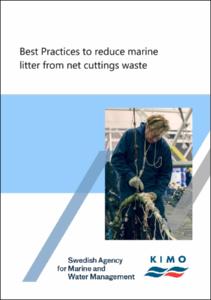| dc.contributor.author | Metcalfe, Ryan | |
| dc.contributor.author | Bentley, Arabelle | |
| dc.coverage.spatial | European | en_US |
| dc.date.accessioned | 2021-09-24T20:51:28Z | |
| dc.date.available | 2021-09-24T20:51:28Z | |
| dc.date.issued | 2020 | |
| dc.identifier.citation | Metcalfe, R. and Bentley, A. (2020) Best Practices to reduce marine litter from net cuttings waste. Shetland, UK, KIMO International for Swedish Agency for Marine and W ater Management, 41pp. DOI: http://dx.doi.org/10.25607/OBP-1652 | en_US |
| dc.identifier.uri | https://repository.oceanbestpractices.org/handle/11329/1731 | |
| dc.identifier.uri | http://dx.doi.org/10.25607/OBP-1652 | |
| dc.description.abstract | The primary source of net cuttings in the North Sea is from trawl nets
that are being repaired on board fishing vessels at sea and on the
quayside in port. Sections of net that have been damaged through
regular wear and tear or by accident are cut from the net and
discarded, through lack of awareness, habit or carelessness. If they are
not removed quickly from the deck of the vessel they can be washed
overboard by storms, high winds, waves or rainwater, or swept
overboard (by design or accident) when the deck is cleaned. If they are
not removed from docks and quaysides they can be carried to the sea
by wind or runoff water (storm drains or directly over the edge), or
swept into the sea during clean-up activities.
Net cuttings can also fall onto the fishing nets on board and be
trapped there, dropping into the sea when the net is rolled up on the
boat or rolled out during regular fishing activities. They can also fall
into the water when nets are transferred from the quay to the boat or
when new nets are taken in use, as waste pieces from manufacturing
can become trapped in the netting.
The following best practice recommendations and examples have
been compiled primarily from the results of the survey undertaken by
KIMO of harbours in four European countries and feedback from face
to face dialogue with harbour staff and fishers. They demonstrate
some of the most simple, practical and inexpensive ways in which
fishers and harbour authorities can reduce the number of net cuttings
ending up in the sea and consequently reduce the negative impacts
caused by this waste to our marine environment and economy. | en_US |
| dc.description.sponsorship | Swedish Agency for Marine and Water Management, | en_US |
| dc.language.iso | en | en_US |
| dc.publisher | KIMO International for Swedish Agency for Marine and Water Management | en_US |
| dc.subject.other | Fishing gear | en_US |
| dc.subject.other | Plastic pollution | en_US |
| dc.subject.other | Net cuttings | en_US |
| dc.title | Best Practices to reduce marine litter from net cuttings waste. | en_US |
| dc.type | Report | en_US |
| dc.description.status | Published | en_US |
| dc.format.pages | 41pp. | en_US |
| dc.description.refereed | Non Refereed | en_US |
| dc.publisher.place | Shetland, UK | en_US |
| dc.subject.parameterDiscipline | Fisheries | en_US |
| dc.description.currentstatus | Current | en_US |
| dc.description.sdg | 14.1 | en_US |
| dc.description.eov | Marine debris | en_US |
| dc.description.adoption | International | en_US |
| dc.description.methodologyType | Method | en_US |
| dc.description.methodologyType | Specification of criteria | en_US |
| obps.contact.contactname | KIMO International | |
| obps.contact.contactemail | info@kimointernational.org | |
| obps.resourceurl.publisher | https://www.kimointernational.org/ | |
 Repository of community practices in Ocean Research, Applications and Data/Information Management
Repository of community practices in Ocean Research, Applications and Data/Information Management
